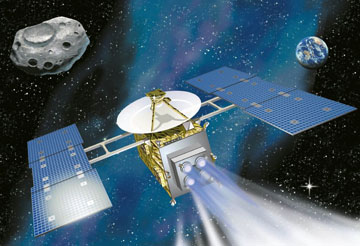 |
Office of Media Relations | |||
News | ||||
|
Science Team Determines Composition of Asteroid Itokawa
For the first time, a group of scientists have an intimate look at a small asteroid, this one dubbed Itokawa. Using data from the Japanese space probe Hayabusa, the team has determined the mineral makeup and surface characteristics of Itokawa and published their findings in Science. Itokawa and other asteroids contain materials relatively unchanged since the birth of the solar system, offering clues to how the system has evolved over time. PROVIDENCE, R.I. — Itokawa, a spud-shaped, near-Earth asteroid, consists mainly of the minerals olivine and pyroxene, a mineral composition similar to a class of stony meteorites that have pelted Earth in the past. This asteroid ingredient list, published in Science, comes courtesy of Hayabusa, the spacecraft launched in 2003 by the Japanese Aerospace Exploration Agency (JAXA). The mission of Hayabusa is to bring back first-ever samples from an asteroid to better understand their role as building blocks of the solar system.  A developing regolith Itokawa, an elongated rocky object nearly as long as five football fields, circles the sun more than 321 million miles away from Earth. Along with a few hundred known asteroids, Itokawa’s orbit is close to Earth’s orbit and was discovered by the Lincoln Near-Earth Asteroid (LINEAR) program, which detects near-Earth asteroids and provides advance warning if any are bound for Earth. Itokawa doesn’t currently pose such a threat, but its close proximity made it a tempting scientific target. A near-infrared spectrometer aboard Hayabusa helped identify Itokawa’s mineralogy, mostly a mixture of the rock-forming minerals olivine and pryroxene, and possibly some plagioclase and metallic iron. But to truly understand what they had, the team turned to Takahiro Hiroi, a Brown University researcher who is expert in determining the composition of asteroids and meteorites, bits of asteroids that have fallen to Earth. Hiroi is a senior research associate in the Department of Geological Sciences at Brown and the operations manager of the University’s NASA-funded Reflectance Experiment Laboratory (RELAB). For the Hayabusa project, Hiroi obtained samples of meteorites from museums, measured them at RELAB, and compared these results with spectral data from Itokawa. Hiroi was able to determine that the mineral composition of the surface of Itokawa was similar to that of LL chondrites, a common class of stony meteorites relatively low in metallic iron. This link helped the team place a probable source of origin for Itokawa: the inner portion of the main asteroid belt, a ring of tens of thousands of rocks orbiting the sun between Mars and Jupiter. Using Hayabusa data, the team was also able to better describe the surface of Itokawa. Much of it is studded with boulders, although the asteroid contains a smoother area known as Muses Sea. This diversity of terrain, the team concludes, may be the result of past meteoroid impacts and space weathering, a rock-altering process due to bombardments by dust particles and solar wind. “We’ve never had a close-up look at such a small asteroid until now,” Hiroi said. “Large asteroids such as Eros are completely covered with a thick regolith, a blanket of looser material created by space weathering. With Itokawa, we believe we have witnessed a developing stage of the formation of this regolith. And these boulders sitting on Itokawa are no different from the meteorites that have fallen on Earth. So we may be seeing an earlier stage of asteroid evolution, of a type that has touched this planet.” NASA and JAXA funded the work. ###### Media Relations Home | Top of File | e-Subscribe | Brown Home Page | ||||